Last Tuesday, Presidential hopeful Jeb Bush publicly released 33 years of tax returns, more than any candidate in history. He likely did this, at least in part, to avoid the pitfalls that Mitt Romney experienced in the 2012 election cycle. Romney begrudgingly released only two years of returns, revealing that he had paid an effective tax rate of 14.1% in 2011, mostly on tax-advantaged investment income. Jeb Bush, on the other hand, reports that he has paid an average effective rate of 36%. This rate makes good headlines and plays well to his political message, but it is unusually high, especially for someone with the means to hire expensive tax advisers. As tax expert Joe Thorndike has stated, "It’s either poor tax planning or very good political planning."
To understand what these tax rates mean in real terms, it's important to know the difference between marginal vs. effective tax rates. Marginal tax rates are what we mean when we talk about tax brackets. However, there's a lot of misunderstanding about how tax brackets actually work. The tax bracket you are in tells you the rate you would pay on any additional income you make this year, but it doesn't mean you pay that rate on all of your income. You pass through all of the lower tax brackets each year, paying those lower rates, before reaching your highest rate.
To illustrate this, let's look at Jane Doe, who is a single person making $90,751 in taxable income this year. This puts her at the very bottom of the 28% tax bracket. (You can see this year's tax brackets and rates at this post by Taxgirl.) To figure her tax, we would first look at the lowest tax bracket, 10%. Jane will pay this rate on the first $9,225 that she made this year. After that, she'll pay 15% on the next dollars she makes until she reaches a total income of $37,450; then 25% from that point until her total reaches $90,750. Only one dollar of her income is above that threshold, so she will pay the marginal rate of 28% only on that one, single dollar. (If she were to get a bonus or any additional income, she would continue to pay that marginal rate on this new income.)
The effective tax rate, on the other hand, is a weighted average of those rates - or more simply, the actual percentage of your overall income you paid in tax. In our example, Jane would pay $18,481.53 in tax, for an effective tax rate of about 20.4%. Of course, a variety of deductions, credits, and additional taxes can push the effective rate in either direction.
The practice of Presidents releasing their tax returns publicly became common in the 1970s, and a number of returns released by Presidents, Vice Presidents and candidates can be found at the Tax History Project. This gives us a great deal of information about the financial situation of these Presidents. Let's delve into this data by comparing the average income they made while in office, and the effective tax rates that they paid. The amounts are adjusted for inflation for better comparison.
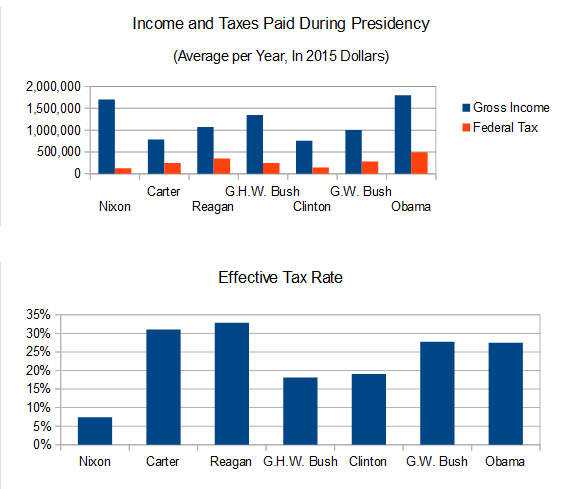
President Obama appears to be the highest-earning of the modern Presidents, though this is slightly deceptive. Most of Mr. Obama's income comes from book royalties, and these have not been even from year to year. He made a total of $5.6 million in 2009, when he was freshly elected and at the height of his popularity; a lot of his books sold that year. Since then, his income has dropped sharply.
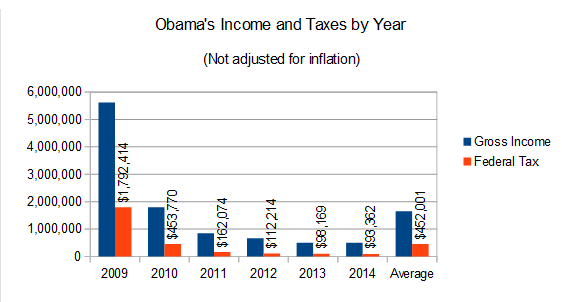
Nipping at Obama's heels is Richard Nixon, who had the second-highest inflation-adjusted income of those we have data for, but paid a far lower tax rate than anyone else. Like Obama, there was some variation from year to year, but for a different reason. His income was relatively level throughout his Presidency, but the amount of tax he paid is another story. In 1969, his first year in office, he paid a seemingly reasonable 22.1% effective tax rate. (This at time when federal tax rates were much higher than they are now, with a top marginal rate of 70%.) The following year, he paid only $793 in federal tax, for a downright comical 0.3% effective rate.
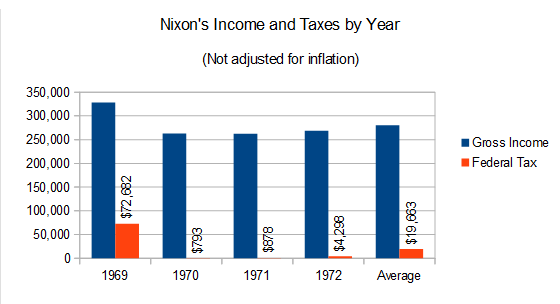
How did Nixon manage to pay so little in tax? If you know his reputation, you could probably guess: he cheated. Hard.
Though the IRS reviewed Nixon's tax returns when they were filed, and accepted them without change, it was later found that these reviews were perfunctory and that the IRS essentially gave him a pass. At the same time, Nixon was using personal tax information obtained from the IRS against his political enemies, so it seems that a number of officials in the agency were in his pocket. Ironically, Nixon's tax situation may have been unraveled by his own attempt to give the illusion of transparency. Nixon announced in 1973 that the IRS had audited his returns and found no problems, stating that "this is good news for people who wonder if presidents are exempt from what the IRS does." This announcement raised more questions than answers for the press, which dug deeper and eventually revealed how little tax Nixon had been paying. This grew to be a major scandal at the time, and had it not become overshadowed by the more ominous Watergate scandal, it might have been Nixon's downfall.
Eventually, Nixon's returns were subjected to a more thorough, independent audit by the Joint Committee on Taxation. They found that he had taken some very large improper deductions, and excluded the gain on real estate he had sold in New York and California, among other things. Nixon was forced to pay $465,000 in back taxes, about half of his net worth at the time.
Nixon's debacle, incidentally, is what inspired the practice of Presidents and candidates releasing their tax returns to the public. His successor, Gerald Ford, started it by releasing summary data of his taxes, in attempt to restore confidence in both the Presidency and the income tax system. Carter took it a bit further by releasing the tax forms themselves, and every President since has done the same.
Where are Presidents making their money? Since 2001, the Presidential salary has been $400,000 per year; prior to that, it was $200,000. (The President also receives a $50,000 expense stipend, which is not included in income.) Presidents may also make money from royalties, trusts and other passive business concerns, and on their personal investments, though they normally keep those investments in a blind trust to avoid conflicts of interest.
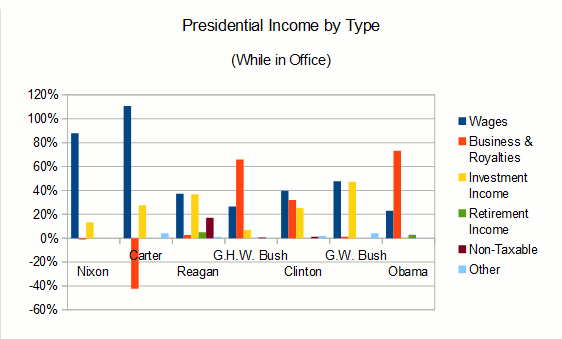
Presidents Nixon and Carter both made their money primarily from their Presidential salaries. Carter's business losses came from his peanut farm; he had the farm placed in a blind trust while he was President, but it was managed poorly, leaving him a million dollars in debt by the time he left office. Other Presidents have had more varied sources of income, with the senior George H.W. Bush and Obama each making the lion's share of their money from book royalties. George W. Bush earned as much interest income from investment trusts as he did from his salary. Reagan made even more from interest, including some from non-taxable bonds.
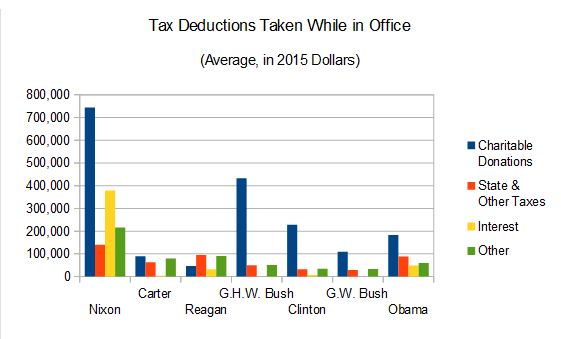
This chart, showing the deductions that the Presidents used, would make Mr. Nixon appear unusually generous to charity. Nope! The majority of this deduction was based on a donation of his Vice Presidential papers to the National Archives in 1969. These papers were appraised with a value of $576,000 (about $3.7 million in today's dollars). Since this deduction far exceeded his income for that year, the excess was carried over year after year. His cash donations were far more meager - as low as $295 in 1972. The method used to appraise the papers seems to have been arbitrary, and the JCT audit later rejected most of the deduction, reducing the value to about $94,000. Not addressed in the audit was whether the papers were even Nixon's to give, since they were generated by the Office of Vice President and were arguably government property.
As for the other Presidents, it may be better to compare their charitable giving as a proportion of their income, rather than the dollar amount. Here, the senior Bush and Clinton are the standouts, with most of the others giving the biblical 10%, and Reagan looking like a bit of a cheapskate.
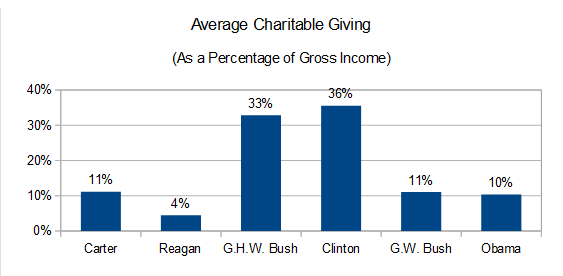
It's important to remember that the taxes that politicians pay are less important than the tax policies that they advocate. Every taxpayer is obligated to pay all of the tax that the law requires, and not a dollar more. Mitt Romney was widely criticized for using loopholes to reduce his tax burden, but what is a "loophole?" It could be defined to include any deduction or credit, up to and including the personal exemptions that nearly all of us use. The question we should ask is not whether Romney, or any political figure (Nixon excluded), paid less tax than they were required to; or perhaps in Jeb Bush's case, more. The questions we ought to ask are whether the tax laws that are in place are benefiting the economy, society, and the country as a whole, and what a candidate would or wouldn't do to change them. The release of personal tax returns by Presidents and candidates, rather than casting judgement on them as a person, should be used to give context to these questions, and their answers to them.
